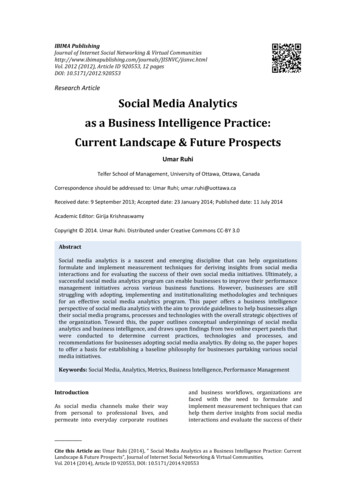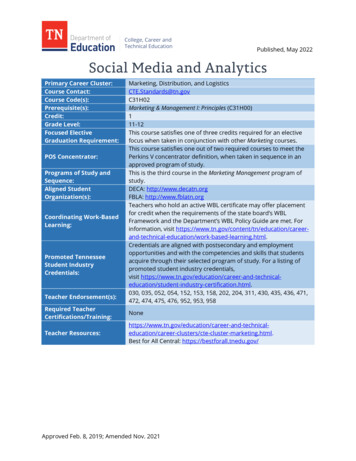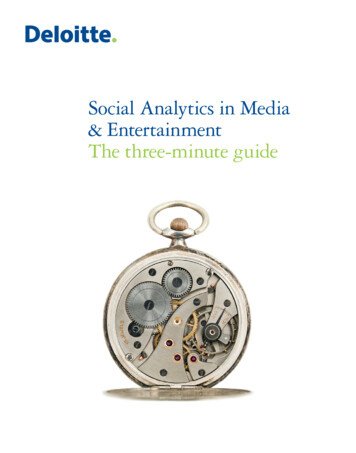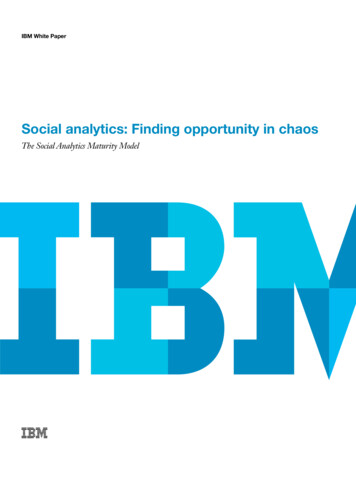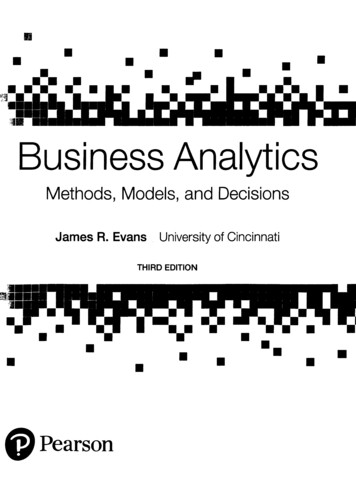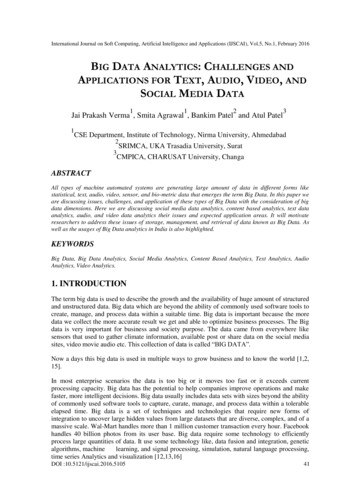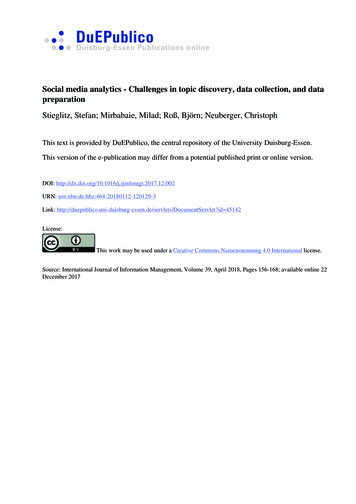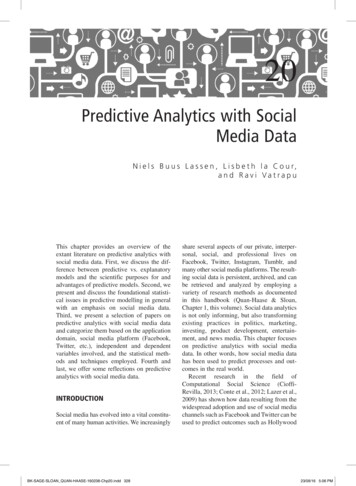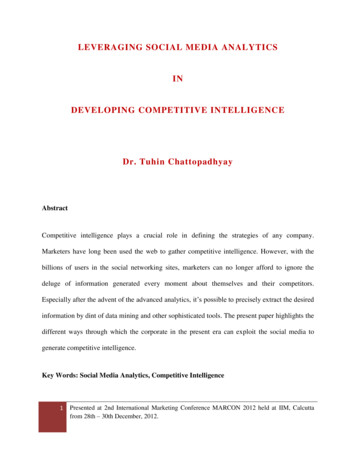
Transcription
LEVERAGING SOCIAL MEDIA ANALYTICSINDEVELOPING COMPETITIVE INTELLIGENCEDr. Tuhin ChattopadhyayAbstractCompetitive intelligence plays a crucial role in defining the strategies of any company.Marketers have long been used the web to gather competitive intelligence. However, with thebillions of users in the social networking sites, marketers can no longer afford to ignore thedeluge of information generated every moment about themselves and their competitors.Especially after the advent of the advanced analytics, it’s possible to precisely extract the desiredinformation by dint of data mining and other sophisticated tools. The present paper highlights thedifferent ways through which the corporate in the present era can exploit the social media togenerate competitive intelligence.Key Words: Social Media Analytics, Competitive Intelligence1Presented at 2nd International Marketing Conference MARCON 2012 held at IIM, Calcuttafrom 28th – 30th December, 2012.
IntroductionOne of the important goals of marketing is to develop deep, long lasting relationships with all thestakeholders that could leave an impact on the success of the firm’s marketing activities (Kotlerand Keller, 2012). Since the exponentially growing popularity of social media like Facebook,MySpace, MeetUp, LinkedIn and Twitter cannot be ignored in satisfying the objectives ofcreating and maintaining relationships, marketers have also started exploiting social networkingsites for multiple objectives. Ehrlich and Carboni (2005) observes that social networking analysisis applicable to a vast range of business problems, for instance, knowledge management andcollaboration; creation of innovative teams and facilitating post-merger integration; humanresources functions like monitoring work force diversity, retention, leadership development;sales and marketing functions like tracking the adoption of new products, ideas and technologies;and last but not the least, industry ecosystem analysis which includes gathering competitiveintelligence. With the deluge of information available after the tsunami of social networkingsites, competitive intelligence (CI) needs to be congregated through appropriate metrics,applications and analytics to achieve hegemony. The objective of CI is to systematically, timelyand ethically gather a wide range of information about the products, policies, customers,suppliers and other related aspects about the competitor and then analyze the information toprovide a complete understanding of the competitor’s strength, weakness, position andperformance which will ultimately develop deep insight for the decision makers. Bill Hoffmanexplores the various facets of effective CI which includes monitoring the competition,understanding its goals, strategy, and tactics; anticipating its actions and understanding theexpected impact of those actions and lastly implementing counter strategies (Exhibit 1)2Presented at 2nd International Marketing Conference MARCON 2012 held at IIM, Calcuttafrom 28th – 30th December, 2012.
Exhibit 1: Competitive Intelligence: The ProcessFocusing on the science and art of collection of competitors’ current information, open sourceintelligence (OSINT) has long been used for the purposes of scanning, finding, gathering,exploitation, validation, analysis, and sharing with intelligence-seeking clients of publiclyavailable print and digital/electronic data from unclassified, non-secret, and grey literaturesources (Fleisher, 2008).Kaplan and Haenlein (2010) define social media as "a group of Internet-based applications thatbuild on the ideological and technological foundations of Web 2.0, and that allow the creationand exchange of user-generated content." Suter, Alexander, & Kaplan (2005) observe socialsoftware as a tool for augmenting human social and collaborative abilities and as a medium forfacilitating social connection and information interchange. O’Reilly (2006) defines Web 2.0 as3Presented at 2nd International Marketing Conference MARCON 2012 held at IIM, Calcuttafrom 28th – 30th December, 2012.
“the business revolution in the computer industry caused by the move to the internet as platform,and an attempt to understand the rules for success on that new platform. Chief among those rulesis this: Build applications that harness network effects to get better the more people use them”.With the advent of social networks like MySpace and FaceBook and business networks likeLinkedIn, expanding sources of information, including employees, current and former executivesand others who have valuable insight regarding a company’s information are accessible (Bose,2008). Facebook was founded by Mark Zuckerberg in February 2004, originally for connectingthe students of Harvard College, where users can populate their own profile page with personalinformation and build up a set of friends (Hopkins, 2012). Dekay (2012) observed that on thewall of a Facebook page, corporations generally post five types of entries, or discussion threads:(1) Direct marketing of products or services;(2) Promotion of sponsored events;(3) Surveys;(4) Informational announcements; and(5) “Fun” postings, usually in the form of questions related to recent or upcoming events.The present paper explores the ways through which the data from these five forms of entries inFacebook could be analyzed to gather competitive intelligence.Research ObjectiveThe objective or aim of this paper is to identify the different metrics and analytics which areapplied to generate competitive intelligence from social media.4Presented at 2nd International Marketing Conference MARCON 2012 held at IIM, Calcuttafrom 28th – 30th December, 2012.
Contribution of the StudyWeb analytics is heavily used for tracking competitive intelligence. Similarly, social mediaanalytics is also used by the organizations to measure their ROI in social media. But, socialmedia analytics as a competitive intelligence tool is yet to gain currency among the corporatefraternity. This paper shows the avenues to the corporate world about how they can exploit socialmedia analytics to develop competitive intelligence.Literature ReviewCompetitive Intelligence and Web AnalyticsWeb analytics was utilized to generate competitive intelligence long before the advent of socialmedia and its associated analytics. Ong, Tan, Ng, Pan and Li (2001) described the use of anapplication code named FOCI (Flexible Organizer for Competitive Intelligence) which helps ingathering, organizing, tracking and dissemination of the information about the competitors byusing text mining techniques. Digimind provides seven main criteria and three related criteria tochoose the right CI software. The seven main criteria are sourcing, collection, monitoring,process and analysis, collaboration and capitalization, dissemination and project development.The three related criteria are security, consultancy and stability of the service provider.Compete.com provides website analytics for the competitors’ websites by providing bydelivering traffic and engagement metrics (Exhibit 2); demographic data; keyword and searchmetrics. The information provided by Compete.com helps in benchmarking and also informationabout the websites that the competitors are using to drive the web traffic.5Presented at 2nd International Marketing Conference MARCON 2012 held at IIM, Calcuttafrom 28th – 30th December, 2012.
Exhibit 2: Traffic of competitor’s website in compete.comNielsen.com also provides a wide range of sophisticated analytical tools to increase thecompetitive intelligence.6Presented at 2nd International Marketing Conference MARCON 2012 held at IIM, Calcuttafrom 28th – 30th December, 2012.
Social Media Analytics without the Application of CISocial media analytics can largely be used to capture the return on investment in social media.However, Sutton (2011) observes that many marketers do not take full advantage of the availablesocial media metrics. Facebook Marketing Solutions (Exhibit 3) provide distinct numbers forTotal Likes, Friends of Fans, People Talking About This and Weekly Total Reach where TotalLikes signify The number of unique people who like a Page, Friends of Fans shows the numberof unique people who are friends with the fans, including the current fans, People Talking AboutThis imply the number of unique people who have created a story about the page in the lastseven days and Weekly Total Reach denotes the number of unique people who have seen anycontent associated with the page in the last seven days. It also provides an insight about thenumber of engaged users i.e. the number of unique people who have clicked anywhere on thepost and virality the number of unique people who have created a story from the page post as apercentage of the number of unique people who have seen it.7Presented at 2nd International Marketing Conference MARCON 2012 held at IIM, Calcuttafrom 28th – 30th December, 2012.
Exhibit 3: Facebook Marketing Solutions8Presented at 2nd International Marketing Conference MARCON 2012 held at IIM, Calcuttafrom 28th – 30th December, 2012.
Facebook provides further options to extract the data in Excel file or CSV (comma separatedvalue) file within a specified date range. Google analytics provides ten social media analyticsapplications like Sprout Social, Campalyst, Argyle Social, AddShoppers Social Analytics forRetail, SocialReport.com, Agencyplatform, Snip-n-Tag Firefox Add-on, Unilyzer, SocialCommerce Insights (TM) and Actionly Social Media Monitoring which provides diverse utilitiesand benefits to the users. Through Sprout Social, it is possible to assess the impact of socialmedia activities on the web traffic of the company’s website. Campalyst helps in assessing ROIby tracking the customer engagement activities on the social media to the purchase by thosecustomers. Argyle Social also helps in identifying the powerful social contents in generatingconversion, revenues and ROI. AddShoppers Social Analytics for Retail helps in trackingrevenue from a product and SKU level through social media. SocialReport.com can be used totrack all the social accounts and blogs and is helpful for understanding conversion rates andsemantic analysis. Agencyplatform helps in tracking and assessing the internet marketingcampaigns. Snip-n-Tag Firefox Add-on helps in measuring web traffic from Twitter where asUnilyzer converts marketing data into meaningful information. Social Commerce Insights (TM)helps in measuring social commerce activities and Actionly Social Media Monitoring helps inassessing social media ROI. techcrunch.com provides the traffic summary by presenting thetweets and clicks graphically (Exhibit 4).9Presented at 2nd International Marketing Conference MARCON 2012 held at IIM, Calcuttafrom 28th – 30th December, 2012.
Exhibit 4: Traffic Summary in techcrunch.comResearch MethodologyCormode, Krishnamurthy and Willinger (2010) identified three methods to collect data from socialnetworks. The first one is API (Application Programming Interface) provided by the OSN to query theentities, properties and relationships. The second one is scraping based where the measurer directlyaccesses the site via a web client. And the third one is Passive network measurement where the measurerunderstands network traffic ‘and sifts out and parses requests to and from the OSN of interest’. In thepresent research, the metrics and analytics are congregated from the current practice across the industrieswhich are applied to social media.10Presented at 2nd International Marketing Conference MARCON 2012 held at IIM, Calcuttafrom 28th – 30th December, 2012.
Results and DiscussionHurd (2010) designs a flow chart of the procedures to be followed for generating competitiveintelligence from the social media. He suggests that one should first start with defining thebusiness problem and then create a competitive intelligence strategy which should detail theinformation required to collect the business problem and lastly developing the insight from thesocial media. Hurd (2011) further enlists the different type of information available about thecompetitors from the social media. The information comprises the details about competitors’clients, employees, vendors, projects, mega-trends that they want to monetize, clients view aboutthe competitors, the key words that are sending traffic and revenue in the marketplace, socialtrends that connects with the sales process, the individual/ organizations work for the competitorsand the information what the competitor have access to about one’s organization i.e. countercompetitive intelligence. SocialMention.com (http://socialmention.com/) provides daily emailalerts about the competitor’s activities and customer’s feedback about the competitors in thesocial media. The metrics like Share of Conversation which is measured as Posts discussingtopic on your brand/ Posts discussing topic can also be used to measure the competitor’spopularity, when used cleverly by changing the numerator to Posts discussing topic oncompetitor’s brand. LeBrun (2009) exhibits the Share of Voice of different competitors in socialmedia (Exhibit 5), when a particular need or product is discussed.11Presented at 2nd International Marketing Conference MARCON 2012 held at IIM, Calcuttafrom 28th – 30th December, 2012.
Exhibit 5: Share of Voice by Different BrandsMelin (2012) shows (Exhibit 6) the way it can further be customized by incorporating the timeframe. This facility also makes it feasible to track whether the competitors’ share of conversationis increasing or decreasing with time. Further research can be pursued to understand the reasonsfor sudden spikes and falls.Exhibit 6: Volume or sentiment spike[Image from Spiral16 Social Research Platform as acknowledged by Melin (2012)]12Presented at 2nd International Marketing Conference MARCON 2012 held at IIM, Calcuttafrom 28th – 30th December, 2012.
Melin (2012) further proposed to find out the website which the competitors are leveraging.Exhibit 7 explores the different types of websites used by the competitors.Exhibit 7: Site type the competitor is leveraging[Image from Spiral16 Social Research Platform as acknowledged by Melin (2012)]Melin (2012) identified the outreaching opportunities by exploring the posts about competitorswhich are found when the customers search about the product [Exhibit 8]. It is also possible tofind out the author of such posts and approach them in the right context.13Presented at 2nd International Marketing Conference MARCON 2012 held at IIM, Calcuttafrom 28th – 30th December, 2012.
Exhibit 8: Posts about the competitors[Image from Spiral16 Social Research Platform as acknowledged by Melin (2012)]Besides, it is easily possible to know from the posts about the individuals who are the loyal to thecompetitors, the demographic and economic profile of such customers and the reasons for theirloyalty. It is also possible to know about the customers who are unhappy with the competitors’brand. Karanikas, Koundourakis, Kopanakis and Mavroudakis observes that text miningtechniques helps in uncovering the implicit meaning of the conversations in the competitors’social media page by applying specialized data mining and Natural Language Processing (NLP)tools which ultimately help in Information Extraction (IE) for Competitive Intelligence. Softwarelike Kapow helps in extracting and structuring data from the social media about the competitorseven without the support of Application Programming Interface (API). Graham (2011) figuredout the ways to measure one’s social media presence, growth and influence relative to thecompetitors (Exhibit 9). He calculated several metrics of the competitors from social media likethe monthly growth of the fans for different competitors across different social media networks,14Presented at 2nd International Marketing Conference MARCON 2012 held at IIM, Calcuttafrom 28th – 30th December, 2012.
the monthly tweet percent growth, the monthly follower percent growth, monthly view percentgrowth in YouTube, the fans in Face Book etc.Exhibit 9: Social Media Competitive Intelligence Snapshot15Presented at 2nd International Marketing Conference MARCON 2012 held at IIM, Calcuttafrom 28th – 30th December, 2012.
Monitter.com (http://monitter.com/) helps to track a few key words in Twitter which helps thetracker to gain an insight on what the conversers are speaking about the competitors.Brandmixer.com reports about one’s brand and the top competitors within a category. comScoreSocial Essentials also provides competitive intelligence from social media by highlightingquantifiable, comprehensible and actionable data on the size and audience composition of thesocial media, reach and frequency of exposures and brand engagement and intention to spend.SAS Social Media Analytics (Exhibit 10) also helps in generating competitive intelligence bydeveloping an insight on how the competitors are perceived in social media. It analyzes theconversation data to recognize the sources and threats of organization reputation and brandimage. It also incorporates predictive analytics to forecast the impact of future social mediaconversations on business results. The text analytics for social media helps in identifying theopinion leader about the competitors’ brand and their impact on the conversation can also beassessed.16Presented at 2nd International Marketing Conference MARCON 2012 held at IIM, Calcuttafrom 28th – 30th December, 2012.
Exhibit 10: SAS Social Media Analytics17Presented at 2nd International Marketing Conference MARCON 2012 held at IIM, Calcuttafrom 28th – 30th December, 2012.
Customer engagement in the social media is the buzzing area in the marketing literature in therecent times. Customer engagement is defined as “behaviors [that] go beyond transactions, andmay be specifically defined as a customer’s behavioral manifestations that have a brand or firmfocus, beyond purchase, resulting from motivational drivers” (van Doorn et al., 2010). The S-OR model suggests that the websites influence users’ online experience and subsequently affectsresponses (i.e. intention to purchase) (Eroglu et al., 2003; Parboteeah et al., 2009). The applicationfrom simplymeasured.com provides the graphical presentation (Exhibit 11) of the ‘Total Engagement’and ‘Engagement as % of Fans’ of the different competing brands in their respective Facebook page.Fan Page Comparison: Total EngagementFan InteractionsTotal K0Engagement as % of 0.5% 1,3210.4% 1,0231%1%0%Exhibit 11: Fan Page Comparison: Total Engagement[Image from https://app.simplymeasured.com/]18Presented at 2nd International Marketing Conference MARCON 2012 held at IIM, Calcuttafrom 28th – 30th December, 2012.
Baird and Parasnis (2011) observed that a company on Facebook can establish a rapport withexisting and potential clients, post sales information, promotions, and new productannouncements and promote those products with engaging drawings and giveaways. Theapplication from simplymeasured.com shows (Exhibit 12) the relative share of engagement bythe competing brands.Relative Share of edFlakeschex5%7%9%47%14%18%Exhibit 12: Relative Share of Engagement[Image from https://app.simplymeasured.com/]19Presented at 2nd International Marketing Conference MARCON 2012 held at IIM, Calcuttafrom 28th – 30th December, 2012.
Fans resemble the followers of a particular brand who want them to be updated with the newarrivals and the latest schemes of that product. The total number of fans maintained by thecompetitors Facebook page are captured by the application from simplymeasured.com and ispresented in Exhibit 13 shown below.Fan Page Comparison: Total ,6340Exhibit 13: Fan Page Comparison: Total Fans[Image from https://app.simplymeasured.com/]20Presented at 2nd International Marketing Conference MARCON 2012 held at IIM, Calcuttafrom 28th – 30th December, 2012.
The application from simplymeasured.com further captures the types of posts the fans create inthe different competitor’s page. It graphically presents (Exhibit 14) the constituent componentsof the posts like sharing of status, links, photos, videos etc. in the competitors’ Facebook page.Fan Page Comparison: Brand PostsStatusLinkPhotoVideoOther9876543210Exhibit 14: Fan Page Comparison: Brand Posts[Image from https://app.simplymeasured.com/]21Presented at 2nd International Marketing Conference MARCON 2012 held at IIM, Calcuttafrom 28th – 30th December, 2012.
The application from simplymeasured.com also measures the average number of brand posts onthe competitors’ Facebook page and is shown in Exhibit 15 given below.Brand Posts Per FrostedFlakes0.4chex0.4Exhibit 15: Brand Posts per Day[Image from https://app.simplymeasured.com/]22Presented at 2nd International Marketing Conference MARCON 2012 held at IIM, Calcuttafrom 28th – 30th December, 2012.
The data are actually captured on a daily basis. So the exact impact of a new launch or a newscheme, or even a controversy can be tracked through the Fan Page Engagement Comparisonover Time shown in Exhibit 16.Fan Page Engagement Comparison Over eschexFan Interactions (Likes,Comments, Posts)5.0K4.0K3.0K2.0K1.0K0Exhibit 16: Fan Page Engagement Comparison over Time[Image from https://app.simplymeasured.com/]23Presented at 2nd International Marketing Conference MARCON 2012 held at IIM, Calcuttafrom 28th – 30th December, 2012.
The engagement details like the Fan Likes, Fan Comments and the Fan Posts of the competingbrands’ Facebook page can be captured through the application from simplymeasured.com and isshown in Exhibit 17.Engagement Details ComparisonFan LikesFan CommentsFan keschex05.0K10.0KExhibit 17: Engagement Details Comparison[Image from https://app.simplymeasured.com/]24Presented at 2nd International Marketing Conference MARCON 2012 held at IIM, Calcuttafrom 28th – 30th December, 2012.
Besides the number of fans and their posts, the application also tracks the significance of thoseposts by the number of responses that those posts fetch. The responses captured by theapplication are in terms of Likes per Post, Comments per Post and Clicks per Post are shown inExhibit 18.Average Response Per PostLikes per Post3.0KComments per PostClicks (bit.ly) per 1403244601400Exhibit 18: Average Response per Post[Image from https://app.simplymeasured.com/]25Presented at 2nd International Marketing Conference MARCON 2012 held at IIM, Calcuttafrom 28th – 30th December, 2012.
Initially, the marketers in Facebook used to measure customer engagement through a number ofmetrics like ‘Likes’, ‘Active Users’, ‘Comments’ etc. However, in October, 2011 Facebookintroduced the metric ‘People Talking About This’ (PTAT) to track customer engagement with aFacebook page. PTAT is a measure of the number of people who have created a story about thepage. The Facebook Page Insights enlists that PTAT includes everyone who: Liked your Page Liked, commented on, or shared your Page post Answered a Question you’ve asked Responded to your event Mentioned your Page Tagged your Page in a photo Checked in or recommended your PlaceFrom the last spring, Facebook also includes friends of fans who interact with a brand's post toaccount of the viral potential of the social network (Creamer, 2012). The PTAT score of thecompeting brands are shown in Exhibit 19 given below.26Presented at 2nd International Marketing Conference MARCON 2012 held at IIM, Calcuttafrom 28th – 30th December, 2012.
People Talking About 0K2,0822.0K0Exhibit 19: People Talking About This[Image from https://app.simplymeasured.com/]ImplicationsIn the present era of mass craze and high level of involvement with the social networking siteslike FaceBook and Twitter, no organization can afford to turn a blind eye to manage theirpresence in the social networking sites. This paper provides an insight to the marketers about theways to track the competitive intelligence from the exponentially increasing and most easilyavailable social networking sites.27Presented at 2nd International Marketing Conference MARCON 2012 held at IIM, Calcuttafrom 28th – 30th December, 2012.
ConclusionThe paper presented the different metrics and analytics to gain an insight into the competitors’popularity and acceptance among the customers. It also helps to explore consumers’ attitude andpurchase intention of their brand vis-à-vis their competitors’ through zettabytes of qualitativedata as well.LimitationThe present research only prescribes the different metrics and analytics through which thecompetitive intelligence can be gathered from social networking sites and have not performedany analysis thereof.Future Research PossibilitiesThe future researchers can use the prescribed metrics and analytics to gather real timecompetitive intelligence for specific organizations. They can formulate strategic and tacticaldecisions based on those data after checking its reliability and validity.28Presented at 2nd International Marketing Conference MARCON 2012 held at IIM, Calcuttafrom 28th – 30th December, 2012.
References:Baird, C. H. & Parasnis, G. (2011),"From social media to social customer relationshipmanagement", Strategy & Leadership, Vol. 39 Iss: 5 pp. 30 - 37Bose, Ranjit (2008),"Competitive intelligence process and tools for intelligence analysis",Industrial Management & Data Systems, Vol. 108 Iss: 4 pp. 510 – 528.Cormode, G., Krishnamurthy, B., and Willinger, W. (2010) A manifesto for modeling andmeasurement in social media. First Monday [Online] 15, 9.Craig S. Fleisher, (2008),"Using open source data in developing competitive and marketingintelligence", European Journal of Marketing, Vol. 42 Iss: 7 pp. 852 – 866.Creamer, M. (2012), Brand Engagement Rate Still 1%, But Facebook Is OK With That.Retrieved from: rate-1-facebook/238317/Dekay, Sam H. (2012),"How large companies react to negative Facebook comments", CorporateCommunications: An International Journal, Vol. 17 Iss: 3 pp. 289 – 299Digimind. How to choose a competitive intelligence software. Retrieved from:http://www.digimind.com/landing/HowTo Choose CI Software.html29Presented at 2nd International Marketing Conference MARCON 2012 held at IIM, Calcuttafrom 28th – 30th December, 2012.
Ehrlich, K. & Carboni, I. (2005). Inside Social Network Analysis. IBM Technical Report. IBMWatson Research Center. 05-10.Eroglu, S.A., Machleit, K.A. and Davis, L.M. (2003), “Empirical testing of a model of onlinestore atmospherics and shopper responses”, Psychology & Marketing, Vol. 20 No. 2, pp. 139-50.Hoffman, B. How competitive intelligence helps companies anticipate and counter theopposition. GALLUP Business Journal. Retrieved 49/james-bond-comes-boardroom.aspx#1Graham, D. (2011). Social Media Competitive Intelligence. Retrieved ia-competitive-intelligence/Hopkins, John L. (2012),"Can Facebook be an effective mechanism for generating growth andvalue in small businesses?", Journal of Systems and Information Technology, Vol. 14 Iss: 2 pp.131 – 141Hurd, B. (December, 2010) Competitive Intelligence with Social Media. Retrieved lligence-with-social-media/Hurd, B. (October, 2011) Competitive Intelligence with Social Media Monitoring. Retrievedfrom: nce-with-social-media-monitoring/30Presented at 2nd International Marketing Conference MARCON 2012 held at IIM, Calcuttafrom 28th – 30th December, 2012.
Kaplan, A.M. and Haenlein, M. (2010), “Users of the world, unite! The challenges andopportunities of social media”, Business Horizons, Vol. 53, pp. 59-68.Karanikas, H., Koundourakis, G., Kopanakis, I. and Mavroudakis, T. A Temporal Text MiningApplication in Competitive Intelligence. Supported by the Parmenides project “Ontology DrivenTemporal Text Mining on Organisational Data for Extracting Temporal Valid elligence.pdfKotler, P. and Keller, K.L. (2012), Marketing Management, 14th ed., Prentice-Hall, UpperSaddle River, NJ.LeBrun, M. (2009). A Social Media Best Practice: The Value of Growing your Share ofConversation.Retrieved from: conversation/Melin, E. (2012). Big Data Means Better Social Media Competitive Intelligence. Retrieved /31Presented at 2nd International Marketing Conference MARCON 2012 held at IIM, Calcuttafrom 28th – 30th December, 2012.
Ong, H.-L., Tan, A.-H., Ng, J., Pan, H., & Li, Q.-X. (2001). FOCI: Flexible organizer forcompetitive intelligence. Proceedings of the 10th international conference on information andknowledge management. New York: ACM pp. 523–525.O’Reilly, T. (2006). Web 2.0 Compact Definition: Trying Again. Available online athttp://radar.oreilly.com/archives/2006/12/Web 20 compact.html.Parboteeah, D.V., Valacich, J.S. and Wells, J.D. (2009), “The influence of web sitecharacteristics on a consumer’s urge to buy impulsively”, Inform
Social Media Analytics without the Application of CI Social media analytics can largely be used to capture the return on investment in social media. However, Sutton (2011) observes that many marketers do not take full advantage of the available social media metrics. Facebook Marketing Solutions (Exhibit 3) provide distinct numbers for

